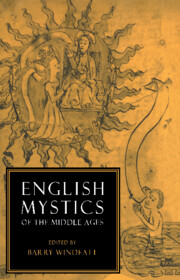Book contents
- Frontmatter
- Contents
- Acknowledgements
- Abbreviations
- Editorial note
- Introductory essay
- RICHARD ROLLE (c. 1300–1349)
- ANONYMOUS
- WALTER HILTON (d. 1396)
- JULIAN OF NORWICH (1342– after 1416)
- 16 Revelations of Divine Love (shorter version)
- 17 Revelations of Divine Love (longer version)
- MARGERY KEMPE (c. 1373– C. 1440)
- ANONYMOUS ENGLISH TRANSLATORS
- RICHARD METHLEY (1451/2–1527/8)
- Notes
- Guide to further reading
- Glossary
16 - Revelations of Divine Love (shorter version)
Published online by Cambridge University Press: 06 July 2010
- Frontmatter
- Contents
- Acknowledgements
- Abbreviations
- Editorial note
- Introductory essay
- RICHARD ROLLE (c. 1300–1349)
- ANONYMOUS
- WALTER HILTON (d. 1396)
- JULIAN OF NORWICH (1342– after 1416)
- 16 Revelations of Divine Love (shorter version)
- 17 Revelations of Divine Love (longer version)
- MARGERY KEMPE (c. 1373– C. 1440)
- ANONYMOUS ENGLISH TRANSLATORS
- RICHARD METHLEY (1451/2–1527/8)
- Notes
- Guide to further reading
- Glossary
Summary
Two versions survive of the ‘Shewings’ or ‘Revelations’ of Julian of Norwich: a longer version preserved in post-medieval copies made by English recusants; and a shorter version (the ‘Amherst’ text), presented here in its entirety from the unique fifteenth-century copy, of which the rubric describes Julian as ‘recluse atte Norwyche and yitt ys on lyfe’ in 1413. Julian was born in late 1342, for she records how she received her revelations in May 1373 when she was thirty and a half years old (Long text, ch. 2). Various wills (the latest from 1416) name Julian as a beneficiary and locate her anchorhold at St Julian's Church, Conisford, in Norwich. Whether Julian was a religious and when she became a recluse remain unknown. She may have been a widow. That her mother and friends were at her sickbed, and that her local priest was sent for, have suggested that she was not enclosed as an anchoress when she received her revelations. By the time Margery Kempe visits ‘Dame Jelyan’, her reputation is clearly established (see below, pp. 230–2).
The Amherst text is now accepted as an authentic early stage in Julian's composition of her text, rather than a scribal abridgement of the longer version. It reads with the immediacy and directness of a transcript of experience, as if written near to the event.1 It already presents not only the narrative sequence of the visions – delineated with a painterly eye – but also the ground of Julian's interpretation of her sixteen revelations.
- Type
- Chapter
- Information
- English Mystics of the Middle Ages , pp. 181 - 213Publisher: Cambridge University PressPrint publication year: 1994



